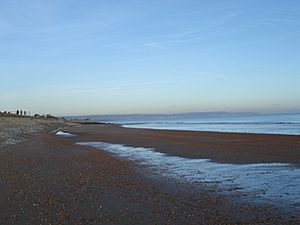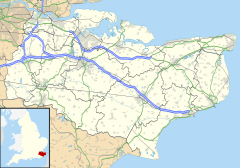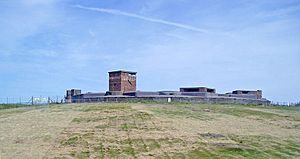Dymchurch facts for kids
Quick facts for kids Dymchurch |
|
|---|---|
 Dymchurch Beach |
|
| Population | 3,752 (2011) |
| District |
|
| Shire county | |
| Region | |
| Country | England |
| Sovereign state | United Kingdom |
| Post town | ROMNEY MARSH |
| Postcode district | TN29 |
| Dialling code | 01303 |
| Police | Kent |
| Fire | Kent |
| Ambulance | South East Coast |
| EU Parliament | South East England |
| UK Parliament |
|
Dymchurch is a village and civil parish located in Kent, England. It sits right on the coast, about five miles (8 km) south-west of Hythe. Dymchurch is also part of the famous Romney Marsh area.
Contents
Dymchurch's Past
The story of Dymchurch began as the Romney Marsh slowly formed over time.
Old Courtroom and Taxes
A building called New Hall was rebuilt in 1575. Before that, an older wooden building had burned down. New Hall was used as a courtroom for the Romney Marsh area. The main judge was called the Leveller of the Marsh Scotts.
This is where a special tax, known as the Scot tax, was created. It was collected from local people to pay for keeping the sea wall in good repair. People who lived just outside the tax area didn't have to pay. This is where the saying "got away scot free" comes from!
Back then, landowners had to grow thorn bushes. These thorns were used to help build the sea wall. People believed thorn twigs could stop sea water. If someone didn't grow the bushes, they faced a very strict punishment.
Smuggling Stories
In the 1600s and 1700s, smuggling was very common along England's south-east coast. Because it was a bit hidden, Romney Marsh was a busy spot for illegal trade.
This exciting history inspired writer Russell Thorndike. He set his famous Doctor Syn smuggling novels in Dymchurch. Every two years, there's a fun celebration of these books, usually around the August Bank Holiday.
Early Surveys
Dymchurch played a part in an important project called the Anglo-French Survey (1784–1790). This survey used math (trigonometry) to connect the Royal Greenwich Observatory in England with the Paris Observatory in France.
For the English part, two main measuring lines were used. One was on Hounslow Heath, and the other was on Romney Marsh. The Romney Marsh line stretched from Ruckinge to High Nook, near the Dymchurch sea wall.
Martello Towers
Several Martello towers were built in the 1800s. These towers were part of a plan to defend the coast. Many of them have since fallen into the sea or are in poor condition.
Tower 23 was fixed up on the outside in the 1970s and is now a private home. Tower 24 was also repaired, using Tower 23 as a guide. In 1969, Tower 24 became the first Martello tower opened to the public. It is now a museum about Martello Towers, owned by English Heritage. Tower 25 is an empty tower that is regularly looked after.
Dymchurch Redoubt Fort
Two large forts, called redoubts, were built along the south coast. They were meant to store supplies for the nearby Martello towers. They were first called "eleven-gun towers."
Dymchurch Redoubt was built between 1806 and 1809. It was similar to a fort in Eastbourne. A caponier is a special part of a fort that lets soldiers fire along the bottom of a dry ditch around the main fort. Dymchurch Redoubt does not have these.
In 1908, a writer named Walter Jerrold described Dymchurch as a "quiet scattered village." It was a small village that grew a lot in the 1930s. Many homes back then were made from old railway carriages. Not many of these are left today.
Dymchurch is now a popular place for holidays. It has a holiday camp, caravan parks, a light railway station, and an amusement park. Today, the village is quite large and mostly focuses on tourism during different seasons.
Second World War Events
Dymchurch saw some important events during the Second World War.
- On August 24, 1940, Dymchurch was bombed. Alfred and Ada Austin were the first local people killed by enemy action. Their house, Sea Breeze, was later rebuilt.
- Martello Tower 25 was used by the Observer Corps as a lookout point. From there, they spotted the first V-1 flying bomb to fly over England.
- In 1942, the primary school was hit directly by a bomb from a plane. Luckily, the teacher and students had gone to the bomb shelter, so no one was hurt.
- In February 1944, a US Air Force Flying Fortress plane had engine trouble. It was returning from a bombing mission and crashed into the police station. Several nearby houses were damaged. One soldier died, and three people were injured.
- In May 1944, a sad accident happened. Twenty-two soldiers died when anti-tank grenades exploded in Dymchurch. The cause of the explosion was not certain. At the investigation, it was suggested it might have been the heat of the sun or a match head falling into a box of detonators.
Dymchurch was also heavily fortified during the Second World War. Bunkers and pillboxes were built. Gun platforms were covered in concrete for machine guns. Artillery positions were made, and an observation post was put up.
In the 1970s, the Redoubt was used by the British Army to train soldiers for fighting in towns. The land is still owned by the Ministry of Defence.
How Dymchurch is Governed
Dymchurch is part of the electoral ward of Dymchurch and St Mary's Bay. In 2011, about 6,291 people lived in this ward. In 2018, Thomas Quaye was chosen to be on the Parish Council.
Famous People and Connections
In January 1867, a ship called the Courier de Dieppe was seen struggling in a storm near Dymchurch. The crew were holding onto the ship's ropes, but one by one they fell into the sea.
After many tries, a rope was thrown to the boat. By then, only one crew member was left. The local church leader, Reverend Charles Cobb, bravely offered to swim to the boat to save the last man. His wife and the crowd cheered him on. He swam about 50 feet to the ship. A local coastguard, John Batist, joined him. Together, they reached the trapped man and brought him back to shore. Everyone cheered their heroic actions. This rescued man was the only survivor from a crew of four.
Reverend Cobb received the Albert Medal of the First Class for his bravery. John Batist received the Albert Medal of the Second Class. The street closest to where this brave rescue happened was later named "Charles Cobb Close" to remember him.
The artist Paul Nash moved to Dymchurch in 1919. He lived there for several years and painted many important pictures. His art was inspired by the sea wall and the countryside around Dymchurch.
Dymchurch is also where the 1964 film First Men in the Moon begins and ends. However, these parts of the movie were not actually filmed in the village.
Getting Around Dymchurch
The main road that leads into the village is the A259.
Romney, Hythe & Dymchurch Railway
The Romney, Hythe and Dymchurch Railway first opened in the 1920s. It closed for a while during the Second World War. Dymchurch railway station was reopened after the war by the famous comedy duo Laurel and Hardy.
Bus Services
Three main bus routes serve the Dymchurch area. These are the 100, 101, and 102 routes. They go from Dover to Lydd-on-Sea or Hastings, passing through Lydd. Stagecoach operates these buses.
Fun Things to Do
Dymchurch Beach
Dymchurch has a sandy beach that has been awarded a Blue Flag. This means it's a very clean and safe beach. The area around it is flat, which is great for walking and cycling.
There are two holiday parks nearby and an amusement park. The amusement park has fun rides like a Ghost Train, Dodgems, and a Log Flume. These rides are sure to keep families entertained!
The Dr Syn Books
Russell Thorndike, who created the character of Doctor Syn, was born in Rochester, Kent, on February 6, 1885.
Thorndike was a British actor and writer. He is best known for his Dr Syn novels, which are set in Romney Marsh. His sister was the famous actress Dame Sybil Thorndike. Russell Thorndike first acted on stage in Cambridge in 1904.
In 1914, Thorndike joined the army. He was badly wounded in 1916 and had to leave the army. He then went back to acting.
While touring the US with his sister, a murder happened outside their hotel. The body was left on the street all night. They couldn't sleep, so they told stories to pass the time. It's said that the character of Dr Syn was created that very night.
Russell Thorndike was a successful actor and writer. In 1922, he played the main role in his own Dr Syn play, which he wrote based on his books.
He wrote seven Dr Syn novels during his life. He passed away on November 7, 1972.
Several movies about Dr Syn were filmed in and around Dymchurch:
- Doctor Syn (1937) starred George Arliss.
- Captain Clegg (1962) featured Peter Cushing. The main character's name was changed for legal reasons.
- The Disney TV film The Scarecrow of Romney Marsh (1963) starred Patrick McGoohan.
Russell Thorndike is buried in the churchyard of St Peter and St Paul's Church in Dymchurch.
Romney, Hythe & Dymchurch Railway (RH&DR)
There is a railway station in Dymchurch. You can often see steam trains running along the Romney Hythe & Dymchurch Railway from here.
Sea Defences
Dymchurch has had a sea wall since Roman times! The first wall was built to protect the harbour at Port Lympne. This original wall was thought to be about 4 miles long and 20 feet high. This wall, along with another called the Rhee Wall, helped turn the muddy land left by the river Limen (Rother) into rich farmland.
In July 2011, a new sea wall was officially opened. It cost £60 million to build. This project helps protect 2,500 homes from flooding. The new wall between the High Knocke Estate and Dymchurch won a British Construction Industry Award in 2011.
The new wall lets people walk along the seashore for the whole length of the village. This is about four miles, from the Hythe Military Rifle Ranges in the East to the St Mary's Bay Boundary in the West. Cyclists can also use it, but they need to get off their bikes for about 500 meters where there are public facilities. Dymchurch Wall
Dymchurch Population and School
The number of people living in Dymchurch has grown since 2001. In 2004, it was estimated to be around 5,820 people.
The village has one primary school. In 2018, school inspectors said it "requires improvement." The school has about 180 students. Most students are of White British background. Fewer students are from minority ethnic backgrounds or speak English as an additional language compared to the average. The number of students with special educational needs or disabilities is about average overall, but higher in some age groups.
Important Buildings
The Norman Church
The church in Dymchurch is called St Peter & St Paul. It is a classic example of Norman architecture, built around 1150. The first church leader recorded was Richard de Bello in 1260. The church stayed mostly the same for almost 700 years.
In 1821, Dymchurch's population grew. So, the church needed to be made bigger. The north aisle was extended, and the roof of the main part of the church was replaced. This gave the church its unique, slightly uneven look today.
Commonwealth War Grave
The village has one war grave from the Second World War. It belongs to Gunner Arthur William Heyhoe, who was 28 when he died on November 20, 1940. He was serving as an anti-aircraft artillery gunner in Dover.
His body was found later that day, washed up on the beach at Dymchurch. He is buried in the Dymchurch cemetery under a Commonwealth War Graves Commission headstone. Arthur is also remembered on the war memorial in Tilney St Lawrence, Wisbech, Norfolk. The local Royal British Legion group remembers him every year.
Local News and Radio
Newspapers
Dymchurch has two newspapers you can buy: the Romney Marsh Herald and the Kentish Express. There are also free newspapers like the Folkestone and Hythe Extra and Your Shepway.
Radio
The local radio station for Dymchurch is KMFM Shepway and White Cliffs Country. You can also listen to county-wide stations like Heart, Gold, and BBC Radio Kent. Cinque Ports Radio 100.2FM is a community radio station for Romney Marsh, Hythe, and Rye. It started broadcasting on March 7, 2022. Before that, Shoreline FM broadcasted, and it's now an online radio service called Shoreline Easy.
See also
 In Spanish: Dymchurch para niños
In Spanish: Dymchurch para niños



